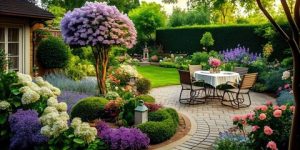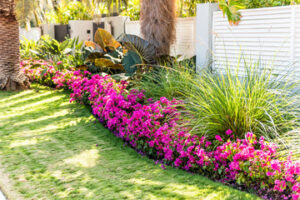Palm Beach Landscaping enhances the beauty of a home and can increase its resale value. It can also improve the environment and lower energy costs.

Form plays a critical role in landscape design. Use lines to create focal points with landscape features like water or flower gardens. Repetition of shapes and structures provides a pulled-together look, but new elements also keep the landscape interesting.
The design of a landscape involves creating a harmonious arrangement of plants and other natural features. This arrangement should also be functional and sustainable. Landscaping can include both hardscapes and softscapes. Hardscaping refers to any man-made materials used in the construction of outdoor spaces, while softscaping includes all the plants and other living elements in a garden or yard. The best landscaping projects take into account several different design principles, including transition, unity, rhythm, variety, and balance.
Plants should be chosen based on their ability to thrive in the local climate and soil conditions. They should be spaced adequately so they can grow to their full size without becoming overcrowded or competing with other plants for nutrients and water. To avoid over- or undersizing a landscape, it is helpful to use an online tool that can help determine how many plants will fit in a given area.
When choosing plants, it is important to consider their mature height and width. This will help you plan the space needed for their growth, as well as the amount of pruning that may be necessary. It is also important to consider the amount of sunlight a particular part of your landscape receives, as it will affect how much sun or shade a particular plant needs.
Some homeowners choose to have their landscape design reflect the natural environment surrounding their home. This can be a great way to create a beautiful and serene setting, as well as increase property value. However, extensive landscape designs can be very difficult to maintain and often require more time and resources than they are worth.
In addition to using native and drought-tolerant plants, it is a good idea to use natural areas for seating and gathering, as well as to incorporate a water feature or other way to add interest to the space. Also, if you are planning to install a new landscape, be sure to choose plants that are water-efficient. You can find tools like the EPA’s WaterSense Water Budget Tool to help you determine how much water your landscape will need.
Materials
The materials used in landscaping help shape the appearance and functionality of a garden, lawn or yard. They can also influence the cost of a project, and some materials are more durable than others. Some of the most common landscape materials include soil, mulch, lights, fencing, retaining wall blocks and edgers, gravel, pavers and bricks, sand, plantations, and water features.
Soil is an important part of landscaping as it provides nourishment to plants and helps with drainage. When choosing soil, it is essential to choose a type that suits the purpose of the project and the climate.
Mulch is an important aspect of any landscaping design and can be used to prevent weed growth and transfer nutrients from the soil. It is also useful around flower and vegetable gardens as it makes weeding and mowing less time-consuming.
Rocks are another hardscape material that can add texture to a garden or lawn and come in many different colors and sizes. They can be used to create a natural-looking stream bed or dry river creek, and they work well in landscapes that feature drought-tolerant plants such as cacti or succulents.
Concrete is a versatile and durable material that can be used to build walkways, patios and walls. It can be poured into forms to create concrete block walls or used as the base for pavers and other paving materials. Concrete is also an excellent choice for creating concrete slabs and retaining walls.
Pavers are a durable and attractive material that can be used to create pathways and patios. They can be made from a variety of materials, including stone, clay, concrete and brick, and they come in several shapes and colors to match any design style. They are also easy to maintain and can withstand heavy traffic and weather conditions.
Metal is an important component of many landscaping projects, and it can be used for fences, grates, planters, screens, gates and more. It is easy to maintain and can withstand harsh weather conditions, making it a great option for busy homeowners. It also adds a modern and sleek look to a garden.
Installation
A customised landscape plan is created to suit your property’s size, location and other factors like light exposure. This helps to ensure your new outdoor area is unique, functional and aesthetically pleasing. Once you approve the general design, your landscaper will assist with materials selection, including pavers, natural stone, appliances, lighting and plants. This will help narrow down options, making the process less stressful and overwhelming for you.
Landscaping is a broad term that includes the construction, maintenance and care of outdoor areas. It includes activities such as planting trees, creating walkways and constructing retaining walls. It also involves the use of water features, as well as incorporating the architecture of homes and buildings into the landscape.
When done correctly, a landscape can increase the value of your home or business and improve your quality of life. It can also be used to create a retreat where you can relax after work, spend time with family or friends, and enjoy the beauty of nature.
A good landscaping project requires careful planning, skilled labor and adherence to local building codes. You may need to obtain a permit, especially for major projects. If you’re unsure about whether you need a permit, it’s best to contact your local council or visit their website. They’ll provide clear explanations of the requirements and helpful study resources.
Using eco-friendly practices and materials will help you reduce your carbon footprint and save money. For example, drip irrigation systems help to conserve water by only spraying the soil as it needs it. You can also use rain barrels to capture rainfall and prevent waste by reducing evaporation. Moreover, a properly designed landscape can include trees and shrubs that help control the temperature of your house, as well as act as windbreaks.
A professionally designed landscape will also be a safe environment for wildlife. Plants produce pleasant scents that are naturally irritating to mosquitoes and other insects. Additionally, certain plants have a high content of essential oils that repel pests.
Maintenance
Landscapes require maintenance in order to stay healthy and beautiful. A well-designed and properly executed landscaping plan will increase property value and create a functional outdoor space for entertaining and relaxing. In addition, landscapes provide environmental benefits such as reducing pollution and climate change through the natural absorption of carbon dioxide by trees.
Maintaining a landscape involves many different tasks, including lawn care, pruning, weeding, mulching, watering, and snow removal. Landscaping professionals perform these services with care and precision to ensure that the yard stays in pristine condition. Depending on the design of the landscape, maintenance may also include adding or subtracting elements. For example, a pond or waterfall may be added to a garden to add visual appeal and sound. Or, a deck or patio may be constructed to create an additional living area.
Landscaping maintenance also includes keeping an eye out for any potential problems that may arise. For example, poison ivy and ground bees can be problematic for children playing in the yard. Landscaping crews should keep an eye out for these hazards and regularly trim or remove them as needed to minimize the risk of injury to children or pets.
Another important part of maintaining a landscape is adapting it to seasonal changes. This can involve anything from planting or removing certain species of plants to changing the amount of watering or fertilization. It is also important to consider the climate of a particular location when making these adjustments. For example, sandy soils may drain more quickly than clay soils, which will require different watering practices.
The final aspect of maintaining a landscape is ensuring that it complies with any local laws or ordinances. This is particularly important for commercial properties, where zoning regulations may dictate what types of landscaping are allowed. If you are unsure of what steps need to be taken to comply with local regulations, it is recommended that you contact a professional. They will be able to help you understand the requirements and assist you in finding solutions that will meet your needs. This will help you avoid costly violations in the future.

